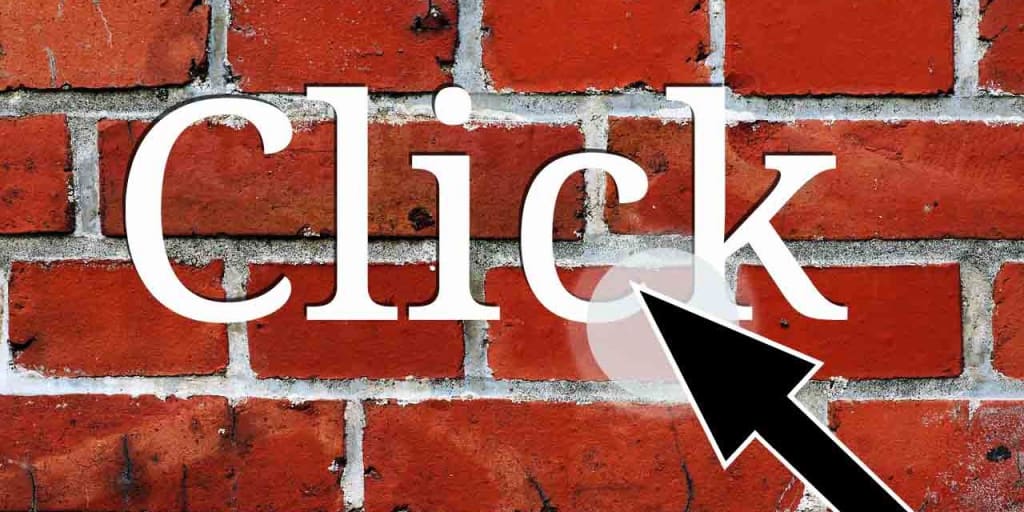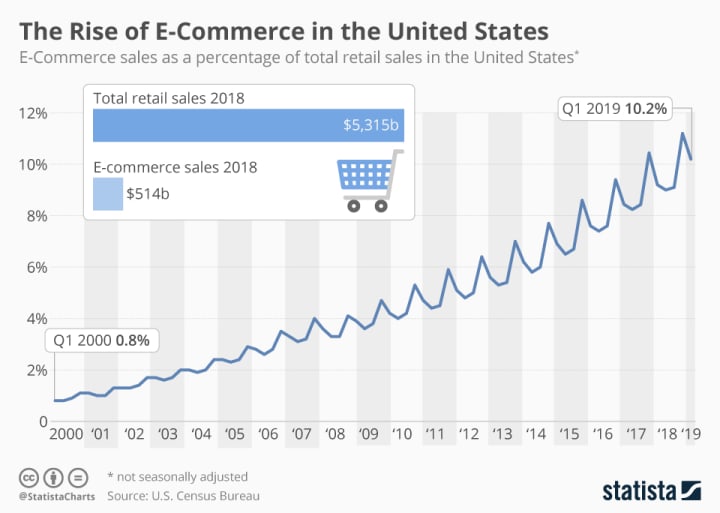Bricks Versus Clicks or Bricks and Clicks
Yes, e-commerce in inexorably growing, but physical sales still dominate—and will for years to come—the retail landscape.

Now two decades ago, in a Fortune article aptly titled" "E or Be Eaten," Stewart Alsop wrote:
"The 'e' in e-business will soon be irrelevant... businesses will make 'e' such a core part of their business that the difference between 'e' and everything else will be nonexistent. Or they won't be businesses any more."

Since I first read that piece—yes, in a real, printed copy of Fortune magazine that arrived in my mailbox delivered by a government employee driving a Jeep, I have used Alsop's adage that e-business will soon simply become business—just the way things are and the way that they have to be—many, many times in my writing, my presentation slides, and in discussions in my work as a strategic management consultant and professor.

Yet, if one is watching, reading, or scanning business news today on one of the many screens in our lives, one might think that Amazon has already taken over the world, and installed Jeff Bezos as our overlord, all in return for free two-day, one-day, and soon maybe, same day delivery—by planes, by trucks, by robots, and maybe even drones!

It seems as if every headline screams that "e" is finally taking over, as brick, and mortar is being taken down brick by brick by the click of a mouse—and increasingly, by the swipe of our finger. With all the talk—and very real, substantive news on the toll being taken by the very real "retail apocalypse," one would think that every retail business is today facing an "extinction-level event" on the level of the dinosaurs looking up to the sky and seeing that meteor about to hit the earth!

As we will see in the data on the growth of online retail, e-business is now indeed business, but not quite in the way one might think. Alsop's prediction, now twenty years on, that the "e" in e-business would become irrelevant, is closer to reality today than ever before. We do see evidence of that each and every day, and we do not have to go out of our way to see it. However, the best evidence is not in the very real human—and real estate toll—that is being taken with all the store closures. Yes, there are fewer physical stores, and there are going to be even fewer moving forward. However, there are—and will always have to be—retail businesses in brick stores—and in all types of buildings. In fact, despite the nightmarish headlines of today and seeming omnipresence of online retail, the future of many lines of business is far, far brighter than most may think—or can even imagine.
All of this can be summed-up in one image. No, it's not a picture of another store closing banner in front of a storefront of yet another household—and historic—name in American retail going under...

... Rather, the true state of the e-evolution can be summed-up in one graphic. It is an image that will likely surprise many... but it really, really shouldn't.
Take a look at the chart below, recently created by Statista. What the analyst firm did was take data from the US Census Bureau, and look at the growth of e-commerce as a percentage of total retail sales over the past two decades. Now as one would expect, this is an upward moving trend in America, as it has been around the world. Indeed, the census data shows that we have seen steady, impressive growth in not just Internet commerce, but the percentage of total retail commerce that takes place online.

Source: Statista (https://www.statista.com/chart/14011/e-commerce-share-of-total-retail-sales/)
However, what might surprise even some very informed businesspeople today is that for all the hype and for all the perception that e-commerce is taking over, well, everything, the numbers actually do tell a different, much more complex story about the modern American economy.
Now, our economy did cross an important threshold in the first calendar quarter of 2019. This year, for the first time, e-commerce sales comprised a full ten percent of the total of over $5 trillion in retail sales in the United States. Now, considering that this means that e-commerce totaled well over half a trillion dollars, this is a huge—and hugely important—market. However, if you asked not just the average man or woman on the street, but even folks in corporate offices, board rooms, universities... anywhere to guess as to the percentage of American retail sales happened online, I would wager a significant sum that they would offer answers twice, three times, five times that 10 percent figure... maybe even more than that, as opposed to the actual, yet quite significant ten milestone percentage that we officially just crossed earlier this year. And BTW, thank you for all that online shopping you did to help the cause—especially while you were "working!"
Why is this figure so seemingly relatively low in a world that seems to be being "Amazoned?" How can the percentage of online retail still be so relatively small, even as online competition is driving more and more brick and mortar stores—and the jobs that go with them—into the proverbial "dustbin of history?" How can e-commerce not be a greater percentage of overall retail sales, even as traditional retailers emphasize the online sales channel more and more. Especially among the leaders in American retailing, from Walmart to BestBuy and from department stores to grocery stores, retailers are increasingly encouraging customers to use their delivery services and to take advantage of the fast-growing BOPUS (“buy online, pick up in store,” also commonly referred to as “click-and-collect”) programs that are becoming ever more common with each passing day. Heck, we now advertise that you do not need to get out of your pajamas to buy groceries at Walmart—what a country!
According to Statista, even if you take the most optimistic perspective on e-commerce as a percent of overall American retail activity, the highest that it can be pegged at is approximately 20 percent of all spending. So how can that number double? Well, in the view of some retail analysts, including Comscore, that higher number is based on e-commerce sales as a percentage of the total retail sales that simply can not be shifted totally online. But wait? I thought everything was moving online at the speed of FedEx and that everything we ever wanted or needed was soon going to be delivered to our door by one of Jeff Bezos' drones?
This higher estimate can be made with a rather simple adjustment based on, well physics. That's because life—as much as we live it on the Web today—does have very real, very physical aspects that simply can't be done online. The laws of physics thus still apply, even in the age of the Web. And practicality still—and always will—matter!

As Statista pointed-out—quite correctly—that there are—and will always be—parts of the retail supply chain that simply cannot be moved online, either at all (with such things as gasoline, which you can't quite get UPS to deliver that to your house) or completely (such as automobile sales and car parts, along with much of the actual stock of grocery and drug stores). And so while the march to an online future is continuing unabated, and yes, likely even accelerating over the next few years and beyond, this does not mean one thing. Not all retail—or maybe not even the majority of retail sales dollars—will ever, even with the most creative of statistical carving or act of mathematical creativity, be part of the e-commerce landscape.
The key thing to remember about all of this—a full two decades into the "E or Be Eaten" world of online commerce—is that today, we can say that Alsop's prediction has come true, as e-business has indeed become business!
Wherever we turn and whatever we may do, the "e" aspects of, well, everything, have enabled all of us to do more. And the same holds true even in the most traditional of businesses, and yes, even those areas of the economy where the laws of physics will not allow for things like gasoline or cars or a whole range of other "things" to be delivered to your doorstep. The true "e" revolution has been behind the scenes, in everything from information systems to business processes to distribution to analytics and much, much more.
While we think about the "face" of e-business being the sites and companies that we encounter on a daily, sometimes hourly basis (e.g. Google, Yahoo, and yes, Amazon, etc.), the real reason that we can say that the 'e' in e-business has truly become irrelevant today is that the world has been transformed by e-commerce. We may even see a plateauing of actual e-commerce sales over time, but that will only be because we reach some "equilibrium" point in the development of the economy where online sales make sense—and where they do not. Until then, there will certainly be more turbulence and disruption, such as what we have seen with all the store closures and all the job losses in retail in recent years—and maybe even worse.
And so whether actual e-commerce sales rise double, triple or more over the coming years and if/when they may actually "peak," history has shown that Adam Smith's "invisible hand" does seem to have a way of sorting things out over time. Yes, I do firmly believe this will happen again in this instance. But do buckle up, for as we have seen over the past two decades, the e-commerce revolution has been—and will—continue to be—a powerful, yet disruptive, force not just in the American economy, but truly worldwide!

About David Wyld
David Wyld ([email protected]) is a Professor of Strategic Management at Southeastern Louisiana University in Hammond, Louisiana. He is a management consultant, researcher/writer, publisher, executive educator, and experienced expert witness. He is the founder and publisher of both The IDEA Publishing (The Best in News, Information and Content Marketing) and Modern Business Press (Creating the Readable—and Enjoyable—Academic Journal—Not an Oxymoron!).
David Wyld’s Online CV
Social Media Links to David Wyld:
on Facebook
on Twitter
on LinkedIn

Professor David C. Wyld
A Simple Way to Show Your Support for Professor Wyld and the Vocal Platform
Like what you just read? Did it make a difference to you? If so, please see and share this article through social media, email, and even the old-fashioned way of printing it off for a colleague or friend!
And while you’re at it, ask yourself a simple question: Was the info worth a buck or two—or perhaps a whole lot more to you, your career, your company? If so, please consider “tipping” (after all, it is the polite thing to do!) using the easy link below. In providing a small tip—even a dollar or two, you not only help support the author's work, but you help keep the unique platform that Vocal Media is building an advertising-free environment—and don't we all need more of that to make our online experiences better today? Please consider showing your support below and voting for good writing and ad-free content on the web by hitting "Send Tip!"
About the Creator
David Wyld
Professor, Consultant, Doer. Founder/Publisher of The IDEA Publishing (http://www.theideapublishing.com/) & Modern Business Press (http://www.modernbusinesspress.com)






Comments
There are no comments for this story
Be the first to respond and start the conversation.